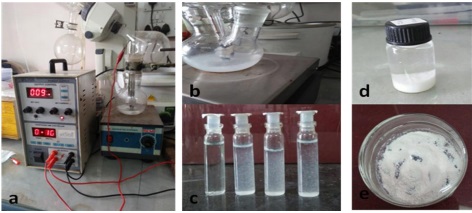Enhanced antimicrobial activity of Zinc oxide nanoparticles with controled particle size by current density
Keywords:
electrochemical reduction method, current density, ZnO NPs, particle size, Tetrabutyl ammonium bromide,, antimicrobalactivityAbstract
In this study, it was found that by using electrochemical reduction method, the current density have played important role in controlling size and shape of ZnO nanoparticles. Where it were synthesized at 9 and 18 mA /cm2. The results of charaterization indicated metallic nature and absorption peak in the UV region. FTIR and EDX confirmed formation of ZnO and removing of capping agent after calcination , XRD, FESEM and HRTEM showed that size of ZnO nanoflower and nanosheets to be 46.54 nm and 37.3 nm at 9 and 18 mA /cm2 respectively. ZnO NPs is pure and polycrystalline with a hexagonal wurtzite phase. The in vitro antibacterial properties of two synthesized ZnO NPs against two types of bacteria; Gram-postive(staphylococcus aureus) and Gram-negtive(xanthomonas) were examined by diffusion method. It was noticed that the smallest-sized ZnO NPs demonstrated a better antibacterial activity against both bacterial strains as compared to the larger ZnO NPs, the inhibitory effect of ZnO NPs increased with the increase in concentration of ZnO NPs.
References
Kiss, F. D., Miotto, R., & Ferraz, A. C. (2011). Size effects on silver nanoparticles ’. Nanotechnology, 275708(22), 1–9.
Ajitha, B., Kumar, Y. A., & Reddy, P. S. (2015). Enhanced antimicrobial activity of silver nanoparticles with controlled particle size by pH variation. Powder Technology, 269, 110–117.
Suchomel, P., Kvitek, L., Prucek, R., Panacek, A., Halder, A., Vajda, S., & Zboril, R. (2018). Simple size-controlled synthesis of Au nanoparticles and their size- dependent catalytic activity. Scientific Reports, (February), 1–11.
Raza, M. A., Kanwal, Z., Rauf, A., Sabri, A. N., & Riaz, S. (2016). Size- and Shape-Dependent Antibacterial Studies of Silver Nanoparticles Synthesized by Wet Chemical Routes. Nanomaterials, 6(74), 2–15.
Reetz, M. T.; Helbig, W. Size-Selective Synthesis of Nanostructured Transition Metal Clusters. J. Am. Chem.SOC, 1994, (1 1), 1401–1402.
Mazur, M. (2004). Electrochemically prepared silver nanoflakes and nanowires. ELECTROCHEM COMMUN, 6, 400–403.
Feng, L., Zhang, C., Gao, G., & Cui, D. (2012). Facile synthesis of hollow Cu 2 O octahedral and spherical nanocrystals and their morphology- dependent photocatalytic properties. Nanoscale Research Letters, 7(4), 1–10.
Lee, C. Y., Li, S. Y., Lin, P., & Tseng, T. Y. (2005). ZnO Nanowires Hydrothermally Grown on PET Polymer Substrates and Their Characteristics. Journal of Nanoscience and Nanotechnology, 5, 1088–1094.
Baglioni, P. (2008). Synthesis and characterization of zinc oxide nanoparticles : application to textiles as UV-absorbers. Journal of Nanoparticle Research, 10(4), 679–689.
Bhatia, S., Verma, N., & Bedi, R. K. (2017). Results in Physics Ethanol gas sensor based upon ZnO nanoparticles prepared by different techniques. Results in Physics, 7, 801–806.
Stan, M., Popa, A., Toloman, D., Dehelean, A., Lung, I., & Katona, G. (2015). Materials Science in Semiconductor Processing Enhanced photocatalytic degradation properties of zinc oxide nanoparticles synthesized by using plant extracts. Materials Science in Semiconductor Processing, 39, 23–29.
Dobrucka, R. (2016). Biosynthesis and antibacterial activity of ZnO nanoparticles using Trifolium pratense flower extract. Saudi Journal of Biological Sciences, 23(4), 517–523.
Gunalan, S., Sivaraj, R., & Rajendran, V. (2013). Progress in Natural Science : Materials International Green synthesized ZnO nanoparticles against bacterial and fungal pathogens. Progress in Natural Science: Materials International, 22(6), 693–700.
Jiang, J., Pi, J., & Cai, J. (2018). The Advancing of Zinc Oxide Nanoparticles for Biomedical Applications. Hindawi Bioinorganic Chemistry and Applications, 2018, 1–18.
Asuncion, E., Dimapilis, S., Hsu, C., Marie, R., Mendoza, O., & Lu, M. (2018). Zinc oxide nanoparticles for water disinfection. Sustainable Environment Research, 28(2), 47–56.
Sharma, R. K., & Ghose, R. (2014). Synthesis of zinc oxide nanoparticles by homogeneous precipitation method and its application in antifungal activity against Candida albicans. Ceramic International, 41(1), 967–975.
Wang, Y., Zhang, C., Bi, S., & Luo, G. (2010). Preparation of ZnO nanoparticles using the direct precipitation method in a membrane dispersion micro-structured reactor. Powder Technology, 202(1–3), 130–136.
Raou, D. (2013). Synthesis and microstructural properties of ZnO nanoparticles prepared by precipitation method. Renewable Energy, 50, 932–937.
Xu, L., Hu, Y., Pelligra, C., Chen, C., Jin, L., Huang, H.,Suib, S. L. (2009). ZnO with Different Morphologies Synthesized by Solvothermal Methods for Enhanced Photocatalytic Activity. Chem. Mater., 21(13), 2875–2885.
Kusumam, T. V. A., Panakkal, T., Divya, T., & Nikhila, M. P. (2015). Morphology controlled synthesis and photocatalytic activity of zinc oxide nanostructures. Ceramic International, 42(3), 3769–3775.
Ba-abbad, M. M., Amir, A., Kadhum, H., Bakar, A., & Takriff, M. S. (2013). The effect of process parameters on the size of ZnO nanoparticles synthesized via the sol – gel technique. Journal of Alloys and Compounds, 550(15), 63–70.
Zak, A. K., Abrishami, M. E., Majid, W. H. A., Yousefi, R., & Hosseini, S. M. (2011). Effects of annealing temperature on some structural and optical properties of ZnO nanoparticles prepared by a modified sol – gel combustion method. Ceramic International, 37(1), 393–398.

Downloads
Published
How to Cite
Issue
Section
License
Copyright (c) 2024 M.A. Al-Hubaishi, S. Gaikwad, A.S. Rajbhoj

This work is licensed under a Creative Commons Attribution 4.0 International License.
Authors contributing to this journal agree to publish their articles under the Creative Commons Attribution 4.0 International License, allowing third parties to share their work (copy, distribute, transmit) and to adapt it, under the condition that the authors are given credit and that in the event of reuse or distribution, the terms of this license are made clear.





